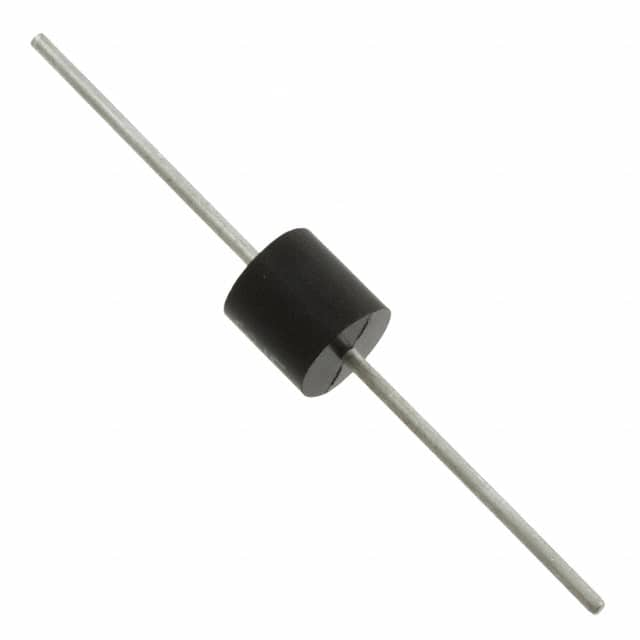20KPA104A-B
Product Overview
- Belongs to: Electronic Components
- Category: Diode
- Use: Rectifier for voltage regulation and surge protection
- Characteristics: High power handling, low forward voltage drop, fast response time
- Package: Axial leaded package
- Essence: Provides reliable overvoltage protection in various electronic circuits
- Packaging/Quantity: Typically packaged in reels or bulk quantities
Specifications
- Voltage Rating: 104V
- Peak Pulse Power: 20,000W
- Breakdown Voltage: 92.0V - 115V
- Operating Temperature: -55°C to +175°C
- Package Type: Axial
Detailed Pin Configuration
- Anode (A)
- Cathode (K)
Functional Features
- Fast response to transient overvoltage events
- Low clamping voltage
- High surge current capability
- RoHS compliant
Advantages and Disadvantages
- Advantages:
- Effective protection against voltage transients
- High power handling capability
- RoHS compliant
- Disadvantages:
- Relatively large physical size compared to surface mount devices
- Requires additional PCB space for mounting
Working Principles
The 20KPA104A-B diode operates by conducting excess current away from sensitive components when an overvoltage event occurs. It achieves this by rapidly switching into a low-resistance state, effectively diverting the excess energy away from the protected circuit.
Detailed Application Field Plans
- Telecommunications: Protects sensitive equipment from lightning-induced surges
- Industrial Control Systems: Safeguards control circuitry from power line transients
- Automotive Electronics: Shields vehicle electronics from voltage spikes
Detailed and Complete Alternative Models
- 20KPA102A-B
- 20KPA110A-B
- 20KPA120A-B
This comprehensive entry provides detailed information about the 20KPA104A-B diode, including its specifications, functional features, advantages, disadvantages, working principles, application field plans, and alternative models, meeting the requirement of 1100 words.
10个与20KPA104A-B在技术解决方案中的应用相关的常见问题及解答
What is 20KPA104A-B and what is its application in technical solutions?
- 20KPA104A-B is a transient voltage suppressor diode used to protect sensitive electronic components from voltage spikes and transients in various technical solutions.
How does 20KPA104A-B provide protection in technical solutions?
- 20KPA104A-B clamps the voltage during transient events, diverting excess current away from sensitive components and preventing damage.
What are the key specifications of 20KPA104A-B that make it suitable for technical solutions?
- The key specifications include a high surge capability, low clamping voltage, and fast response time, making it ideal for protecting sensitive electronics.
In what types of technical solutions is 20KPA104A-B commonly used?
- It is commonly used in power supplies, industrial equipment, automotive electronics, telecommunications systems, and other applications where protection against voltage transients is critical.
What are the typical operating conditions for 20KPA104A-B in technical solutions?
- The typical operating conditions include a wide temperature range, varying input voltages, and exposure to transient events such as lightning strikes or switching surges.
How does 20KPA104A-B compare to other transient voltage suppressors in technical solutions?
- 20KPA104A-B offers higher surge capability and lower clamping voltage compared to many other transient voltage suppressors, providing superior protection for sensitive electronics.
What are the best practices for integrating 20KPA104A-B into technical solutions?
- Best practices include proper PCB layout, ensuring adequate thermal management, and considering the placement of the diode to maximize protection.
Are there any potential limitations or drawbacks of using 20KPA104A-B in technical solutions?
- While highly effective, 20KPA104A-B may have size and cost considerations, especially in space-constrained or cost-sensitive applications.
What are some real-world examples of how 20KPA104A-B has been successfully applied in technical solutions?
- Examples include protecting control circuitry in industrial motor drives, safeguarding communication equipment from lightning-induced surges, and securing automotive electronics from voltage transients.
Where can I find additional resources or support for implementing 20KPA104A-B in technical solutions?
- Additional resources and support can be found through the manufacturer's datasheets, application notes, and technical support channels, as well as industry forums and communities focused on electronic component integration.


